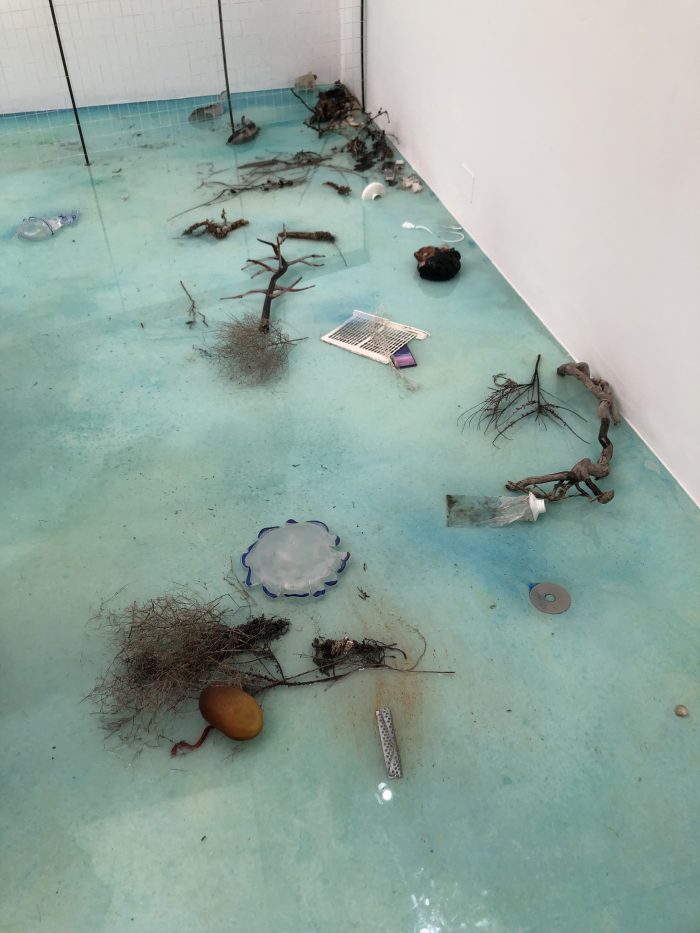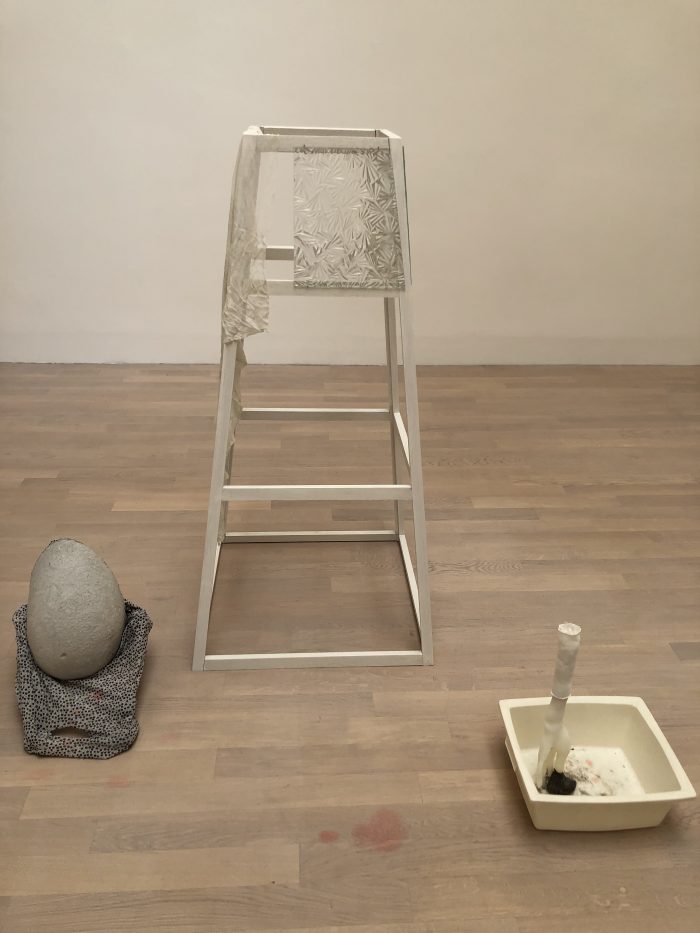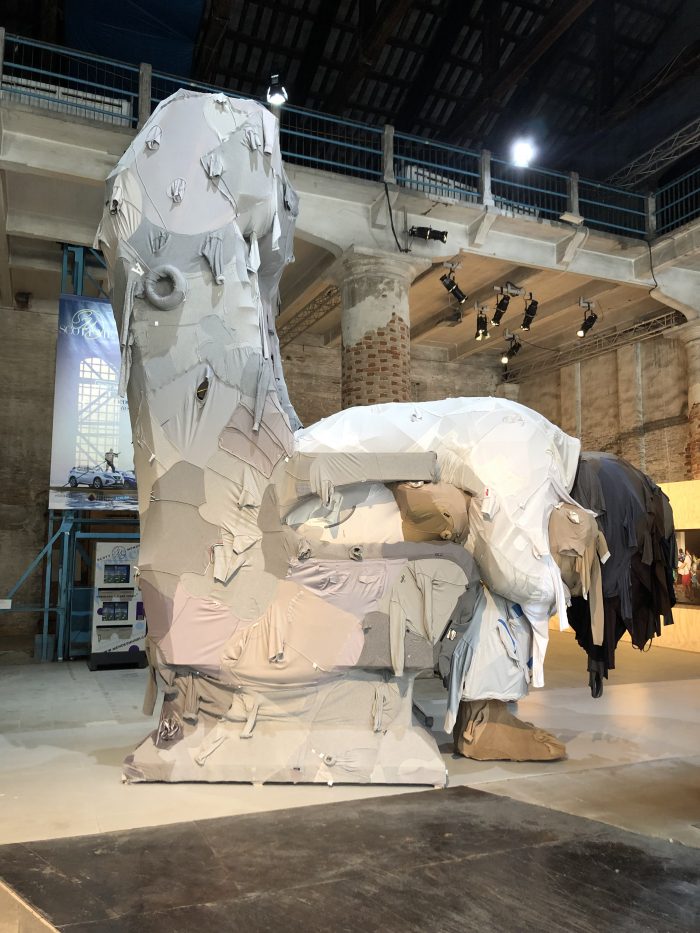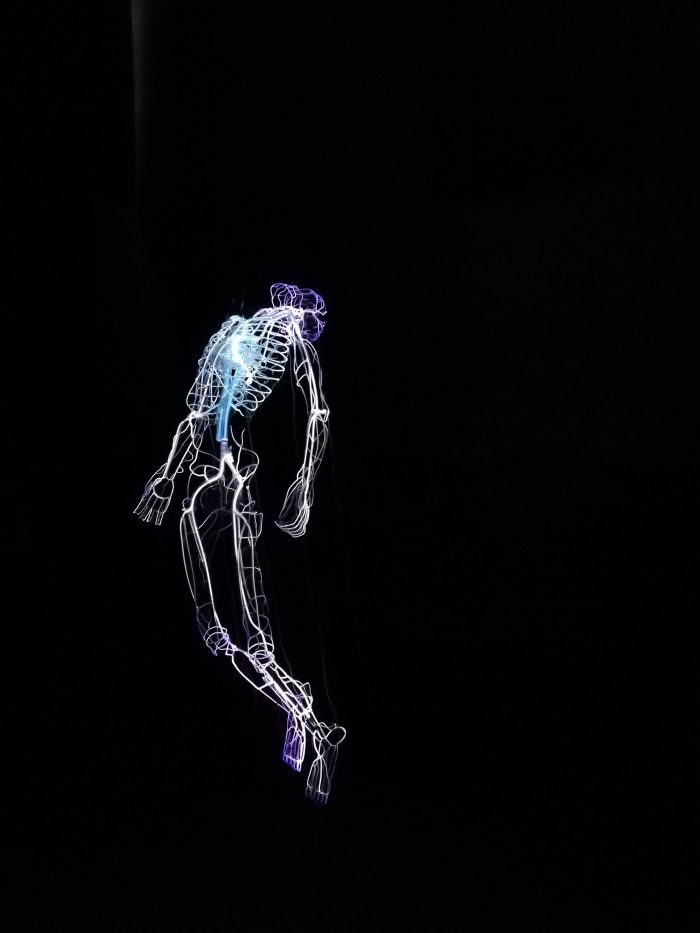
06.07.2020
One year after the 2019 Venice Biennale, Laura Petrecca rereads into the event as a dystopia that now echoes 2020’s realities.

We crossed the sea in a small boat that seemed to break with each crashing wave. The horizon was made only of a gradation of sky where I could imagine, even with journey’s speed, the fish waking up below. And beyond that, the city. But above all, nature under the sun, resisting an archipelago of houses, an architecture in tension. In each interior something different, propositions that, at times, seemed like cynical premonitions that could only exist simultaneously with an always more creative reality.
First, I went through a dirt road to discover a fragile world on a large blue surface. It was impossible not to compare it with the sea that I had just crossed; both had that celestial interior, but in this one, the opposite seemed to have unfolded. Among the items that were carefully arranged there were plastic, broken telephones, natural waste, and eye-catching objects created in a fragile glass-like material, such as a man’s head with light eyes or an octopus whose journey I would later discover. The combination, in some way, maintained a certain beauty, perhaps because of the light that touched them and reflected on them, perhaps because of the noble quality of the material in spite of the toxic waste they evoked. I walked through the crystallized trash, staring at it and having to look at it carefully. With a slightly forced innocence that made the way easier, I could be amazed by the skills with which it was elaborated or at the precision of colors.
As I left that blue world, I plunged into a dark room— which, by mistake, I first assumed was the exit—where a film about a group of young people on a journey was being shown. I didn’t know what time in the movie I came in. Around the screen, there were seats made of sand on a surface that resembled a fantasy at the bottom of the sea. They were an extension of that underwater world I’d seen before. Those who were on the screen, perhaps friends, presented the very essence of memory. The images, which were shown in a staggered and dreamlike montage, were filmed at home, the actors could be any of us, and yet the film could be perceived as a treasure to be discovered or an archaeological piece. At that time, I found it hard to believe that videos of travels or adventures, of people together wouldn’t be possible. They seemed to be part of a common memory that in that stage of sand and fantasy had begun to bury itself.
Is it only through the artifice that we may recognize the urgent agony?
Crossing a line in the woods that separated one house from the other, since the beginning, I felt I was in a story or a dream. I left that world of memories of the present to enter another; the familiarity was more individual this time and perhaps gloomier. The atmosphere was known to me, with wooden floors and white walls, objects of a home arranged with the intention of building a body or a moment that does not fully integrate, and for that reason, leaves a certain melancholy. A large space for few objects; the light coming in through the window seemed to have a constant air of respite. And everything that was missing, the space between one object and another, communicated something too: that absence could cause as much concern as the presence itself.

It seemed as if the scene had been perfectly arranged after something important had happened, something that was probably not good. Or as if we arrived at a scene in which we could only try to reconstruct with difficulty, always remaining dissatisfied. What remained to be placed together was the inner life of the home, which seemed to have vanished all at once. I left there still with an air of dreaminess; people were walking on the grass and talking quietly, some were also walking silently. You could feel the heat rising as midday came.
I leaned against a tree trying to understand the map of houses; looking up, a part of the city could be seen on the other side of the water. An immobile landscape, always the same, motionless in time, as opposed to the new places I had to now enter. A fictional world set up long ago, that of Venice, tourism, and postcards, living on a par with the worlds imagined in every house and space.
In these fragments, I could sense an entire presence that was overwhelming, that of the present that cannot be seen or taken. A present that escapes due to our obsession with the linearity of time.
But these created worlds, even in their incredible forms, seemed to contain more elements of reality than the ones we are used to, which seem fictional. These elements were subtle and caught me unawares, as something that would grow over time and reveal itself later. As if I discovered in those dreams, in the signs and the artists’ ability to conjugate them, a kind of hallucinated premonition that affirmed what is inevitably changing.
In these fragments, I could sense an entire presence that was overwhelming, that of the present that cannot be seen or taken. A present that escapes due to our obsession with the linearity of time. At the same time, those creations didn’t seem to be completely new or strange to me, they conversed with much of what I already knew. What was disturbing was that which was recognizable but slightly altered. And having to force myself to see what, perhaps, in my daily recount I would like to let go.
I put the map aside and decided to go ahead without planning a route. Maybe because of looking away or getting lost in my head, I forgot that I was walking and suddenly appeared in front of a big shed where a woman was looking at me. Me? I realized that I had lost my group or that, if they were close, I could find them alone in the darkness of that big shed full of objects and situations. I could see her from the entrance, her eyes were still, with the slow blinking of one who is calm inside the halo of one’s own vibration. Maybe she was calling me, but only so I’d go see her but not get too close. Next to that big androgynous face, there were other images of her life. The excess of skin, of shine, of silky and long hair, everything seemed to show in its maximum expression some of our obsessions with images, such intimacy that tries to be intimate but is all staged. The need to show the stage and its splendor, having lost any will to hide the artifice. Maybe I had done it before, I had already seen someone like that; with the uncomfortable feeling that comes from being the one who looks at a life that tries to be intimate but is all for show. This produces an annoying pleasure, which is exhausted with endless images. Features that pretend to be beautiful and exacerbated become grotesque, they achieve the common denominator. They become normalized. I decided to get away from her for I was tired of her looking at me but also of having to see her myself.


A rag doll crouched, pensive. It desperately tried to stand still while its owner, a good giant, came to fetch it. For someone like me, its body was made of so many fabrics of clothing; it’s strange to be in a world with so many presences of another species, and also to be one of the smallest. It looked a little defeated too. Something like that was happening to me too; I was starting to feel bad about what I was seeing, knowing and not knowing what the trick was, needing a little bit of what was outside and known to me. Near the next artwork, two girls were helping each other with their portraits.
A familiar voice, finally: that of a friend. He was looking at me while he took off a helmet that looked as if it was from a video game, to offer it to me. But I said no. “It’s a war simulator,” he explained, but I didn’t want to see it, at least not yet. Instead, I started to walk quickly to a figure suspended in the middle of the darkness, it glowed and had strong colors, somewhat fluorescent. It was a suspended skeleton; it had the exhausted gesture of one who is rising or giving up, floating alone in a dark and silent environment that, again, somehow conveyed certain tranquility to me. I saw that I was near the door; people I had not noticed during my run through that pavilion were coming out and going to other places. I rushed out too.

The sound of the machine was constant now, it could be heard from the previous rooms. As I was going through them looking at some paintings, the spaces were more illuminated, there were more people around; suddenly the journey seemed to have returned to that same familiar place than an exhibition usually is. But the sound became louder as I went on and that altered any stroll-like feel. I arrived then in front of a transparent cube. Inside was a very large machine similar to a backhoe that picked up and threw a slightly dark red liquid that looked like blood. The movement was constant, up and down, from the outside to the center. It was inevitable for me not to be impressed by the apparently organic material being dominated by the machine. The machine managed to maneuver it to its liking, made it take different shapes, organized it in circles to then disorganize it, to then scattered it again, doing what it wanted with it. The machine seemed to take over everything, it could be felt from the other rooms, it became the center of the room. Contained in that transparent cube, the rest of the artworks and also us became more fragile.
The curtain of mist condensed near the door of that pavilion, a mist that had to be crossed on the way out and seemed to wake you up. People were dispersing, plants were shining outside, the green was becoming more alive and not far away the boats were anchored, always the same boats. I approached the water, the surface was dark, I could no longer imagine what was inside, I could only see the other side reflected as a perfect opposite.
—
The works referred to in this essay are: Deep See Blue Surrounding You by Laure Prouvost, British Pavilion by Cathy Wilkes, Body En Thrall by Martine Gutierrez, Robert Henry Lawrence Jr. 2018 by Tavares Strachan, Trojan, 2016-17 by Yin Xiuzhen, Can´t help myself by Sun Yuan y Peng Yu, in the context of the 2019 Venice Biennale.
Comments
There are no coments available.